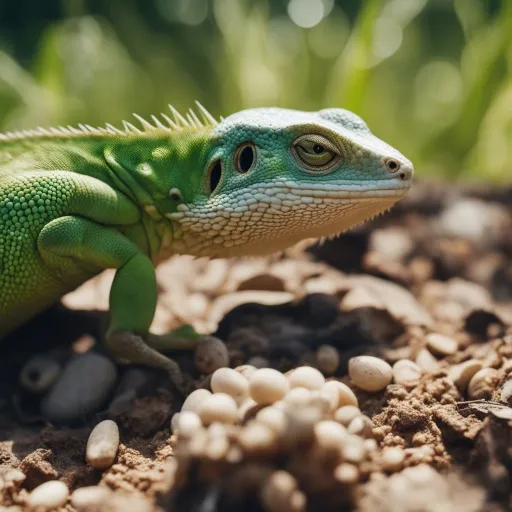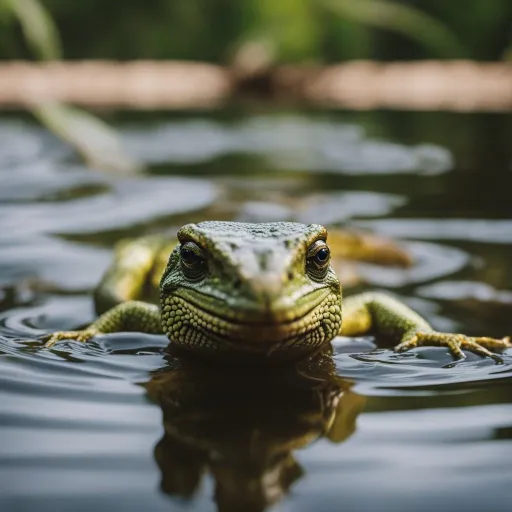You’ve always wondered about the reproductive habits of lizards, specifically how many eggs they lay. In this article, you’ll discover the fascinating answer to your longtime question.
From tiny geckos to massive Komodo dragons, lizards have diverse reproductive strategies, with some species laying just a few eggs while others can produce dozens.
Get ready to uncover the secrets of lizard reproduction and gain a whole new appreciation for these scaly creatures.

Factors Affecting Lizard Egg Production
Environmental Conditions
Environmental conditions play a crucial role in lizard egg production. Factors such as temperature, humidity, and daylight duration can significantly impact the reproductive success of lizards.
Different lizard species have specific requirements when it comes to environmental conditions for egg production.
Species Variation
Each lizard species has its own unique reproductive characteristics, including clutch size.
Some species may lay only a few eggs per clutch, while others may lay a larger number.
These variations in clutch size are influenced by factors such as evolutionary history, habitat, and ecological niche.
Age and Size of the Lizard
The age and size of the female lizard also influence the number of eggs she can produce.
Generally, older and larger female lizards have the capacity to produce a greater number of eggs compared to their younger and smaller counterparts.
This is because larger females have more space to accommodate larger clutches, and their reproductive systems are more developed.
Reproductive Cycle
The reproductive cycle of lizards, which includes mating, egg development, and egg-laying, also affects the number of eggs produced.
Different lizard species have different breeding seasons and mating behaviors. The timing and frequency of mating can impact the number of eggs a female lizard produces during a particular breeding season.
Availability of Resources
The availability of resources, such as food and suitable nesting sites, can have a direct impact on lizard egg production.
Adequate nutrition is necessary for females to allocate energy towards egg production. If resources are scarce, females may produce smaller clutches or delay reproduction until conditions improve.
Typical Lizard Clutch Sizes
Small Lizard Species
Small lizard species generally lay smaller clutches compared to larger species. Examples of small lizard species include geckos and anoles.
These species typically lay clutches consisting of 1-2 eggs or occasionally a few more.
The smaller clutch sizes in these species may be due to limited energy availability and the challenges of carrying larger clutches.
Medium-sized Lizard Species
Medium-sized lizard species, such as some skinks and fence lizards, tend to have larger clutch sizes compared to their smaller counterparts.
Clutch sizes in this category usually range from 3-10 eggs. The increase in clutch size compared to small lizard species is attributed to the larger body size and reproductive capacity of these species.
Large Lizard Species
Large lizard species, such as iguanas or monitor lizards, have the potential to lay even larger clutches.
Clutch sizes in these species can vary greatly, typically ranging from 10-50 eggs or more.
The larger clutch sizes in these species are often associated with their larger body size and the ability to produce and carry more eggs.
Variation within Species
It is important to note that there can be significant variation in clutch sizes within a particular lizard species.
Factors such as geographical location, environmental conditions, and individual reproductive capacity can lead to variation in clutch sizes even within the same species.
Comparative Studies
Comparative studies between different lizard species have been conducted to understand the underlying factors that influence clutch size.
These studies have provided valuable insights into the evolutionary and ecological forces shaping the variation in clutch sizes across lizard species.
Extreme Cases: Largest and Smallest Clutch Sizes
Largest Clutch Sizes
While large lizard species generally lay larger clutches, there are certain exceptional cases where the clutch size can reach unusually high numbers.
For instance, the Green Iguana (Iguana iguana) may lay clutches comprising up to 75 eggs.
This exceptionally large clutch size is likely due to the large size and reproductive capacity of this species.
Smallest Clutch Sizes
In contrast to the largest clutch sizes, some lizard species have extremely small clutch sizes.
For example, the rare Tuatara (Sphenodon punctatus) lays a single egg per clutch, making it the lizard species with the smallest clutch size known.
This unique reproductive strategy may be influenced by various factors, including limited resources and the need for extensive parental care.
Explanation for Extreme Clutch Sizes
The extreme clutch sizes observed in certain lizard species can be attributed to a combination of factors.
Large clutch sizes often serve as an adaptation to predation pressure, ensuring a higher chance of at least some offspring surviving.
Smaller clutch sizes may be favored when resources are limited, parental care is extensive, or environmental conditions are unfavorable for successful incubation.
Strategies for Maximizing Egg Survival
Nest Site Selection
Nest site selection is a critical aspect of maximizing egg survival. Female lizards carefully choose optimal locations to lay their eggs, considering factors such as temperature, moisture levels, and protection from predators.
Selecting suitable nesting sites enhances the chances of successful egg incubation and hatching.
Nest Construction
Some lizard species construct nests to provide additional protection for their eggs. These nests can range from simple burrows in the ground to intricate structures made of vegetation and soil.
By constructing nests, female lizards create a microenvironment that helps regulate temperature and moisture, increasing the chances of egg survival.
Egg Guarding and Parental Care
Certain lizard species exhibit parental care behaviors, where the female or sometimes even the male actively guards the eggs against potential threats.
This parental care can involve staying near the nest, defending against predators, and regulating temperature and humidity levels.
Such behaviors significantly increase the survival chances of lizard eggs.
Predator Avoidance
Predators pose a significant threat to lizard eggs. Female lizards employ various strategies to reduce the risk of predation, such as camouflaging the nest, burying eggs deeply, or avoiding high-risk areas.
By minimizing the chances of predator detection and accessing the nest, female lizards increase the survival rate of their eggs.
Temperature and Incubation
Temperature plays a crucial role in the successful development of lizard eggs. Different lizard species have specific temperature requirements for proper incubation.
Some species rely on external sources of heat, such as sunlight, to provide the necessary warmth, while others generate heat through physiological processes.
Maintaining optimal incubation temperatures is vital for the survival and proper development of lizard embryos.
Threats to Lizard Eggs
Predation
Predation is one of the main threats to lizard eggs. Various predators, including birds, mammals, snakes, and even other lizards, target lizard nests and feed on the eggs.
The level of predation pressure varies depending on the habitat and the presence of predators.
The high predation risk emphasizes the importance of effective strategies for nest site selection and predator avoidance.
Environmental Factors
Environmental factors can also pose challenges to the survival of lizard eggs. Extreme temperatures, drought, flooding, and changes in habitat conditions can negatively impact egg development and hatching.
Environmental alterations due to climate change and habitat destruction further increase the vulnerability of lizard eggs to these threats.
Human Impact
Human activities, such as habitat destruction, pollution, and introduction of invasive species, can have detrimental effects on lizard populations and their reproductive success.
Destruction of nesting sites, contamination of water sources, and the introduction of predators or competitors can directly or indirectly affect the survival of lizard eggs.
Conserving lizard habitats and minimizing human impact is vital for protecting their reproductive capabilities.
Reproductive Strategies: Quantity vs. Quality
R vs. K Selection
Lizard species exhibit different reproductive strategies based on the concept of R vs. K selection. R-selected species prioritize high reproductive output, producing numerous offspring with relatively low parental care.
These species typically have small clutch sizes and rely on sheer numbers to ensure survival. K-selected species, on the other hand, prioritize fewer, but more well-developed offspring with higher parental investment.
They often have larger clutch sizes and dedicate more resources to each individual offspring.
Trade-offs
The choice between quantity and quality of offspring involves trade-offs for lizard species. R-selected species have a higher reproductive potential but face greater risks of offspring mortality due to limited parental care and resources.
K-selected species invest more in individual offspring, reducing the number of potential offspring they can produce.
Each strategy has its own advantages and disadvantages depending on the specific ecological context.
Evolutionary Advantage
The evolutionary advantage of these reproductive strategies depends on environmental conditions and the specific niche occupied by a given lizard species.
R-selected species may thrive in unpredictable and fluctuating environments, where rapid population growth can compensate for higher mortality rates.
K-selected species, on the other hand, may excel in stable environments with ample resources, allowing for greater individual offspring survival and population stability.
The Role of Male Lizards in Reproduction
Mating Behavior
Male lizards play a significant role in the reproductive process, starting with mating behavior. Male lizards employ various strategies to attract females and secure mating opportunities.
These strategies can include territorial displays, courtship rituals, and competition with other males for access to females.
Sperm Competition
Sperm competition is common among lizard species, where multiple males mate with a single female.
Male lizards have evolved mechanisms to increase their chances of fertilizing the female’s eggs, such as the production of larger quantities of sperm or sperm that is more competitive in fertilization.
Male Parental Care
While female lizards generally bear the primary responsibility for egg production and parental care, certain lizard species exhibit male parental care behaviors.
Male lizards may guard nesting sites, protect eggs from predators, or even provide some level of thermoregulation during incubation.
Male parental care can enhance the survival rates of eggs and contribute to the reproductive success of the species.
Influence on Egg Production
Male lizards can indirectly influence egg production through their role in mate selection and in competing for mating opportunities.
Some studies suggest that male quality, such as size or genetic fitness, can influence the reproductive investment of females, potentially leading to variations in clutch sizes.
Male lizards’ contribution to egg production extends beyond direct involvement in egg development and parental care.
Unusual Cases and Adaptations
Parthenogenesis
Parthenogenesis, the ability of females to produce offspring without fertilization by males, is observed in certain lizard species.
These species can reproduce entirely through asexual means, resulting in offspring that are essentially clones of the mother.
Parthenogenesis is an unusual adaptation that allows females to maximize their reproductive output without the need for males.
Oviparous vs. Viviparous Species
Lizards display a range of reproductive modes, with some being oviparous (laying eggs) and others being viviparous (giving birth to live young).
Oviparous species typically lay eggs that develop externally, while viviparous species retain the eggs internally until they are ready to give birth.
This diversity in reproductive modes reflects the adaptations that lizards have evolved to suit different environmental conditions.
Other Egg-laying Adaptations
In addition to the variations in clutch size and reproductive modes, lizards have developed fascinating adaptations related to egg-laying.
Some species bury their eggs in sand or soil, while others deposit them in leaf litter or within tree cavities.
These adaptations help protect the eggs from predators, regulate temperature and humidity, and ensure successful incubation.
Conserving Lizard Populations and Their Reproduction
Habitat Preservation
Preserving and protecting lizard habitats is crucial for the conservation of their reproductive abilities.
This includes conserving natural environments, restoring degraded habitats, and implementing effective land-use practices.
By maintaining suitable habitats, we can ensure the availability of resources and nesting sites necessary for successful lizard reproduction.
Awareness and Education
Raising awareness about the importance of lizards and their reproductive needs is essential for their conservation.
Promoting education about lizard biology, ecology, and the threats they face can help foster a greater understanding and appreciation for these unique creatures.
This awareness can lead to more informed conservation efforts and better management of their habitats.
Conservation Efforts
Efforts to conserve lizard populations and their reproductive capabilities involve various strategies.
These may include captive breeding programs, habitat restoration projects, implementing legislation and regulations to protect lizard habitats, and collaborating with local communities to promote sustainable practices.
By actively engaging in conservation efforts, we can safeguard lizard populations and ensure the continuity of their reproductive processes.
Final Thoughts
Lizard reproduction is influenced by a multitude of factors, including environmental conditions, species variation, age and size of the lizard, reproductive cycle, and resource availability.
Clutch sizes vary among different lizard species, with small species typically laying smaller clutches and larger species capable of laying larger clutches.
Extreme cases of clutch sizes exist, with some lizards laying exceptionally large or small clutches.
Lizards employ various strategies to maximize egg survival, such as nest site selection, nest construction, egg guarding, predator avoidance, and maintaining optimal incubation temperatures.
However, lizard eggs face threats from predation, environmental factors, and human impact.
Understanding the balance between quantity and quality of offspring, reproductive strategies, and the role of male lizards in reproduction provides valuable insights into lizard reproductive biology.
Unusual cases and adaptations, including parthenogenesis and the diversity of egg-laying behaviors, highlight the remarkable evolutionary history of lizards.
Conserving lizard populations and their reproductive capabilities requires habitat preservation, awareness, education, and targeted conservation efforts.
In conclusion, studying lizard egg production offers a fascinating glimpse into the intricate dynamics of reproduction in these remarkable creatures.
By understanding and appreciating the factors that affect lizard egg production, we can contribute to the conservation and preservation of these important reptilian species.



